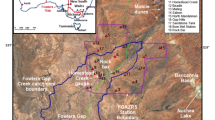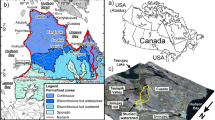Abstract
A 2.5 km stretch of a sandur (glacial outwash plain) neighbouring a wetland in South-east Iceland was monitored from 1 September 2015 to 2 September 2016. Improved understanding of the hydrological regime at this sandur-wetland boundary is warranted as local farmers are losing ground to the frequent flooding of their wet meadows despite the existence of elevated berms. A series of water wells were installed across a sandur-wetland boundary, to monitor water table fluctuations, determine flooding extent and assess groundwater inflow. Flooding occurred rapidly in the sandur during 19 weather events, which included modest and heavy rainfall, and glacial outburst floods (jökulhlaups). Water levels on the South-western edge of the wetland responded in sync with the sandur during flooding, indicating a connectivity via groundwater exchange across the coarse, non-vegetated berm. We estimated that between 6 June and 31 August, 11,275 m3 of groundwater flowed from the sandur to this part of the wetland. This contrasted with the South-eastern edge of the wetland, which had an older, vegetated berm. Here, only 7446 m3 of groundwater flowed from the sandur to the wetland. Overall, these modest water inputs accounted for 76% of seasonal evaporation loss from the wetland (191 mm).











Similar content being viewed by others
Data Availability
Data and material are available from the author and co-authors and metadata will be deposited with the Polar Data Catalogue.
Code Availability
Not Applicable.
References
Abnizova A, Young KL (2010) Sustainability of high Arctic ponds in a polar desert environment. Arctic 63:67–84
Aðalgeirsdóttir G, Jóhannesson T, Björnsson H, Pálsson F, Sigurðsson O (2006) Response of Hofsjökull and southern Vatnajökull, Iceland to climate change. Journal of Geophysical Research: Earth Surface 111:F3. https://doi.org/10.1029/2005JF000388
Ágústsdóttir AM (2015) Ecosystem approach for natural hazard mitigation of volcanic tephra in Iceland: building resilience and sustainability. Natural Hazards 78:1669–1691
Arnalds Ó (2008) Soils of Iceland. Jökull 58:409–421
Arnalds Ó (2010) Dust sources and deposition of aeolian materials in Iceland. Icelandic Agricultural Sciences 23:3–21
Arnalds Ó, Dagsson-Waldhauserova P, Olafsson H (2016a) The Icelandic volcanic aeolian environment: processes and impacts—a review. Aeolian Research 20:176–195
Arnalds Ó. Guðmundsson J, Oskarsson H, Brink S, Gisladóttir F (2016b) Icelandic inland wetlands: characteristics and extent of draining. Wetlands 36(4):759–769
Bennett BG (1975) Hydrologic and seminentary aspects of the “Schei” Sandur, Ellesmere Island, N.W.T. Unpublished BA thesis, McMaster University, 163 pp.
Beylich AA, Liermann S, Laute K (2010) Fluvial transport during thermally and pluvially induced peak runoff events in a glacier-fed mountain catchment in western Norway. Geografiska Annaler 92(2):237–246
Björnsson H (2003) Subglacial lakes and jökulhlaups in Iceland. Global and Planetary Change 35(3):255–271
Björnsson H, Pálsson F (2008) Icelandic glaciers. Jökull 58:365–386
Bullard JE, Mockford T (2018) Seasonal and decadal variability of dust observations in the Kangerlussuaq area, West Greenland. Arctic, Antarctica and Alpine Research 50(1):S100011. https://doi.org/10.1080/15230430.2017.1415854
Church M, Ryder JM (1972) Paraglacial sedimentation: a consideration of fluvial processes conditioned by glaciation. Geological Society of America Bulletin 83(10):3059–3072
Dagsson-Waldhauserova P, Arnalds Ó, Olafsson H, Hladil J, Skala R, Navratil T, Meinander O (2015) Snow–dust storm: unique case study from Iceland, March 6–7, 2013. Aeolian Research 16:69–74
Einarsson MÁ (1984) Climate of Iceland. In: van Loon H (ed) Climates of the oceans. Elsevier, Amsterdam, pp 673–697
Einarsson B (2009) Jökulhlaups in Skaftá: a study of a jökulhlaup from the Western Skaftá cauldron in the Vatnajökull ice cap, Iceland. Technical report VI 2009–006 from the Icelandic Meteorological Office, 21–34
Guðmundsson MT, Bonnel A, Gunnarsson K (2002) Seismic soundings of sediment thickness on Skeiðarársandur, SE-Iceland. Jökull 51:53–64
Hazen A (1911) Discussion: dams on sand foundations. Transactions, American Society of Civil Engineers 73:199
Heine RA, Pinter N (2012) Levee effects upon flood levels: an empirical assessment. Hydrological Processes 26:3225–3240
Hjulstrom F (1955) The ground water: the Hoffellssandur-a glacial outwash plain. Geografiska Annaler 37:234–345
Hodgson R, Young KL (2001) Preferential groundwater flow through a sorted net landscape, arctic Canada. Earth Surface Processes and Landforms 26(3):319–328
Hodson AJ, Gurnell AM, Washington R, Tranter M, Clark MJ, Hagen JO (1998) Meteorological and runoff time-series characteristics in a small, high-Arctic glaciated basin, Svalbard. Hydrological Processes 12(3):509–526
Icelandic Meteorological Office (IMO) [Veðurstofa ĺslands] (2015) Possibly the largest jökulhlaup. https://en.vedur.is/about-imo/news/nr/3207.
Icelandic Meteorological Office (IMO) [Veðurstofa ĺslands] (2016a) A minor glacial outburst flood in Skaftá. https://en.vedur.is/about-imo/news/a-minor-glacial-outburst-flood-in-skafta.
Icelandic Meteorological Office (IMO) [Veðurstofa ĺslands] (2016b) Climate Summary - The weather in Iceland 2015. https://en.vedur.is/about-imo/news/nr/3273.
Icelandic Meteorological Office (IMO) [Veðurstofa ĺslands] (2017) Climate Summary - The weather in Iceland in 2016. https://en.vedur.is/about-imo/news/the-weather-in-iceland-in-2016.
Jónsdóttir JF (2008) A runoff map based on numerically simulated precipitation and a projection of future runoff in Iceland. Hydrological Sciences Journal 53(1):100–111
Krigström A (1962) Geomorphological studies of Sandur plains and their braided rivers in Iceland. Geografiska Annaler 44(3–4):328–346
Lafleur PM (1990) Evapotranspiration from sedge-dominated wetland surfaces. Aquatic Botany 37(4):341–353
Levy A, Robinson Z, Krause S, Waller R, Weatherill J (2015) Long-term variability of proglacial groundwater-fed hydrological systems in an area of glacier retreat, Skeiðarársandur, Iceland. Earth Surface Processes and Landforms. 40(7):981–994
Long N, Millescamps B, Guillot B, Pouget F, Bertin X (2016) Monitoring the topography of a dynamic tidal inlet using UAV imagery. Remote Sensing 85(5):387. https://doi.org/10.3390/rs8050387
Loukas A, Vasiliades L, Dalezios NR (2000) Flood producing mechanisms identification in southern British Columbia, Canada. Journal of Hydrology 227(1–4):218–235
Luthin JN (1966) Drainage engineering. Wiley, New York
Magilligan FJ, Gomez B, Mertes LAK, Smith LC, Smith ND, Finnegan D, Garvin JB (2002) Geomorphic effectiveness, Sandur development, and the pattern of landscape response during jökulhlaups: Skeiðarársandur, southeastern Iceland. Geomorphology 44(1):95–113
Magnússon E, Gudmundsson MT, Roberts MJ, Sigurðsson G, Höskuldsson F, Oddsson B (2012) Ice-volcano interactions during the 2010 Eyjafjallajökull eruption, as revealed by airborne imaging radar. Journal of Geophysical Research: Solid Earth 117(B7). https://doi.org/10.1029/2012JB009250
Maizels J (1991) Origin and evolution of Holocene sandurs in areas of jökulhlaup drainage, South Iceland. In: Maizels J, Caseldine C (eds) Environmental change in Iceland: past and present. Kluwer Academic Publishing, London, pp 267–302
Maizels J (1997) Jökulhlaup deposits in proglacial areas. Quaternary Science Reviews 16(7):793–819
Mancini F, Dubbini M, Gattelli M, Stechhi F, Fabbri S, Gabbianelli G (2013) Using unmanned aerial vehicles (UAV) for high-resolution reconstruction of topography: the structure from motion approach on coastal environments. Remote Sensing 5(12):6880–6898
Marren PM (2002) Fluvial–lacustrine interaction on Skeiðarársandur, Iceland: implications for Sandur evolution. Sedimentary Geology 149:43–58
Marsh P, Rouse WR, Woo MK (1981) Evaporation at a high Arctic site. Journal of Applied Meteorology 20(6):713–716
Montreuil O, Cudennec C, Merot P (2011) Contrasting behaviour of two riparian wetlands in relation to their location in the hydrographic network. Journal of Hydrology 406:39–53
Priestley CHB, Taylor RJ (1972) On the assessment of surface heat flux and evaporation using large-scale parameters. Monthly Weather Review 100(2):81–92
Roberts MJ (2005) Jökulhlaups: a reassessment of floodwater flow through glaciers. Reviews of Geophysics 43(1):RG1002. https://doi.org/10.1029/2003RG000147
Robinson ZP, Fairchild IJ, Russell AJ (2008) Hydrogeological implications of glacial landscape evolution at Skeiðarársandur, SE Iceland. Geomorphology 97(1–2):218–236
Rosenberry DO, Hayashi M (2013) Assessing and measuring wetland hydrology. In: Anderson JT, Davis CA (eds) Wetland techniques, Foundations, vol 1. Springer Science, Dordrecht, pp 87–225
Rosenberry DO, Stannar DI, Winter TC, Martinez ML (2004) Comparison of 13 equations for determining evapotranspiration from a prairie wetland, cottonwood Lake area, North Dakota, U.S.A. Wetlands 24(3):483–497
Sen Z (1995) Applied hydrogeology for scientists and engineers. CRC Press, Boca Raton
Þorkelsson B, Karlsdóttir S, Gylfason ÁG, Höskuldsson Á, Brandsdóttir B, Ilyinskaya E, Högnadóttir Þ. (2012) The 2010 Eyjafjallajökull eruption, Iceland: Report to ICAO-June 2012
Van Vliet-Lanoë B, Laurent M, Bahain JL, Balescu S, Falguères C, Field M, Hallégouët B, Keen DH (2000) Middle Pleistocene raised beach anomalies in the English Channel: regional and global stratigraphic implications. Journal of Geodynamics 29(1):15–41
Woo MK, Guan XJ (2006) Hydrological connectivity and seasonal storage change of tundra ponds in a polar oasis environment, Canadian high Arctic. Permafrost and Periglacial Processes 17:309–323
Woo MK, Steer P (1983) Slope hydrology as influenced by thawing of the active layer, resolute NWT. Canadian Journal of Earth Science 20:978–986
Young KL, Woo MK (2004) Queen Elizabeth Islands: water balance investigations. International Association of Hydrological Sciences 290:152–163
Young KL, Scheffel HA, Abnizova A, Siferd JR (2017) Spatial and temporal dynamics of groundwater flow across a wet meadow, polar bear pass, Bathurst Island, Nunavut. Permafrost and Periglacial Processes 28(2):405–419
Younger PL (2006) Groundwater in the environment, an introduction. Wiley-Blackwell, London
Acknowledgements
We would like to thank York University for research funds to Dr. Kathy L. Young and Harold-Alexis Scheffel. The Government of Canada provided logistical funds to H-Alexis Scheffel through the Northern Scientific Training Program. Dr. Tarmo Remmel provided us with surveying and geomatic advice, while Kristinn Guðjónsson and his wife Helga Þorsteindóttir are thanked for their friendship and logistical support while in Iceland. We are especially grateful to Mr. Hannes Jónsson and his wife Guðný M. Ström Óskarsdóttir, who allowed us to undertake this study on their property in South-east Iceland. Finally, we appreciate the helpful and insightful comments from two anonymous reviewers. Their input has helped to improve the manuscript.
Funding
We would like to thank York University for research funds to Dr. Kathy L. Young and Harold-Alexis Scheffel. The Government of Canada provided logistical funds to H-Alexis Scheffel through the Northern Scientific Training Program.
Author information
Authors and Affiliations
Contributions
Both H-AS and KY designed the scope of the project and KY selected the study site. H-AS undertook 80% of the fieldwork and analysis. KY assisted with fieldwork (20%) and provided assistance on the analysis of the data (20%). H-AS drafted the figures and both authors contributed equally to the writing of the manuscript, and approved it for submission to Wetlands.
Corresponding author
Ethics declarations
Ethics
Not Applicable.
Consent to Participate
Not Applicable.
Conflict of Interest
Not Applicable.
Additional information
Publisher’s Note
Springer Nature remains neutral with regard to jurisdictional claims in published maps and institutional affiliations.
Rights and permissions
About this article
Cite this article
Scheffel, HA., Young, K.L. Water Level and Groundwater Dynamics across a Sandur-Wetland Landscape in Response to Seasonal and Episodic Events, South-East Iceland. Wetlands 41, 27 (2021). https://doi.org/10.1007/s13157-021-01426-5
Received:
Accepted:
Published:
DOI: https://doi.org/10.1007/s13157-021-01426-5




